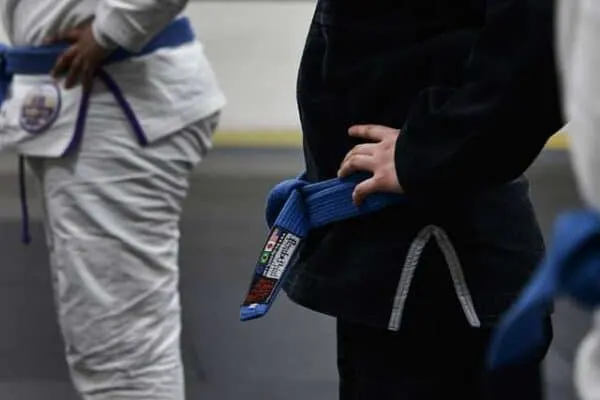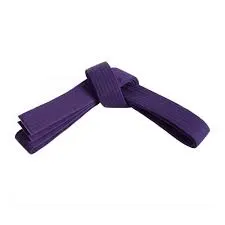Brazilian Jiu-Jitsu (BJJ) belt ranking system might seem too complex or even confusing to some people. But overall, the belt order in BJJ is quite simple and easy to understand when explained right.
BJJ color belt ranks are separated into two main groups, each with five different solid color belt ranks. Each color belt has stripes or sub-ranks in the youth belts. Youth (below 16 yrs of age): white, gray, orange, green, black. Adults (above 16 yrs of age): white, blue, purple, brown, and black.
Keep reading this article to learn all about the history of the BJJ belt system, how it works in practice, and how long it takes to get each belt on average. After reading this article, we are confident that you will have a pretty good understanding of the BJJ ranking system and everything you need to know about the BJJ Belt ranking system.
The History of the BJJ Color Belt Ranking System
BJJ was created on the foundation of Judo base by brothers Carlos and Helio Gracie. Thus, jiu-jitsu shares many similarities with judo regarding techniques and belt ranks. At the same time, the color belt ranks in jiu-jitsu differ in certain aspects. But the core concept of the ranking system remains the same as the one in judo.
At the beginning of the 20th century, the father of Judo, Kano Jigoro, searched for a grading system to improve the learning process. His main idea was to somehow separate beginners from more experience students and instructors.
The solution he came up with was the color belt ranks. A piece of cloth students has to wear around their waist indicates their skill level and experience. In the initial form, there were only two belts: white and black. But over the years, Jigoro would make many changes, add more belt colors, and separate the ranking system between the youth and senior students.

Since the inception of the Judo colored belt ranking system, many other martial arts would adopt judo ranking systems, such as karate, taekwondo, and Brazilian jiu-jitsu, to indicate the level of their student’s skill set.
When BJJ began to emerge in the 1920s and 1930s, most schools had three different belt ranks:
- White belt – is a color belt worn by beginner students who are yet to master the art of jiu-jitsu
- Light blue – is a belt worn by practitioners who have reached the level of the instructor
- Black belt – is a belt worn by the very true masters of jiu-jitsu
Over the years, the BJJ belt ranking system would undergo many changes and add more color belts. However, the most significant change came in 1967 when the color belt ranks became standardized globally. This system is still in use in modern days, along with many others such as:
- Helio Gracie Lineage system
- JJGF developed by Rickson Gracie
- Gracie Barra belt ranking system
The belt ranks are divided into two main categories:
- Adult belts for people above 16 years of age
- Youth belts for kids below 16 years of age.
RECOMMENDED READING: BJJ vs Judo – Key Differences and Core Similarities
Youth BJJ Belt System (Fully explained)
Youth belts are reserved for students between 5 and 16 years old. The system includes five color belt ranks: White, Grey, Yellow, Orange, and Green.
Each of the five belts consists of three additional sub-rank groups: a white stripe, a black stripe, and a solid color belt.
To make it simple and easy to understand, here is how it all looks in a table:

The next thing to remember is those additional degrees (stripes) within each belt rank. Depending on the school policies and the way they operate, there can be:
- 12 stripes per belt (Monthly system)
- 4 stripes per belt (Triannal system)
- 3 stripes per belt (Quartile system)
For example, once you earn a Gray belt, you will need to earn 4 stripes within the Gray belt before moving up in rank and earning a Yellow belt. Students usually receive stripes for being consistent and regularly showing up to classes.
Most academies prefer to utilize the monthly system. But note that the one in your area might use one of the remaining two.
Once students turn 16 years old, they switch to Adult BJJ ranks. It’s worth noting that the level you reached in the youth ranks has its equivalent in the adult ranks. It usually goes like this:
- Grey, Yellow, and Orange belts may become blue belts
- Green-Black belts may become purple belts if the main instructors agree
RECOMMENDED READING: Top 3 Best Martial Arts For Kids – A Basic Guide For Parents
Adult BJJ Belt System
Adult BJJ belt ranks are reserved for students who are 16 years old or older. The system consists of five different color belt ranks, with four stripes (IBJJF) per belt. In most schools, stripes are awarded for the time spent on the mats, consistency, progress, knowledge, and performance in competition.
Once a student earns a black belt, there are six additional black belt ranks for the levels between 0-6 and red belt ranks for the levels between 7 and 10. Sounds a bit confusing? Here is a table to better understand it:
| Belt color | Level of Skill | Minimum age |
| White Belt | Beginner belt | No age limit |
| Blue Belt | Intermediate stage | 16+ |
| Purple Belt | Intermediate stage | 17+ |
| Brown Belt | Advanced stage | 18+ |
| Black Belt | Advanced stage | 19+ |
| 1st degree black belt | Master | / |
| 2nd degree black belt | Master | / |
| 3rd degree black belt | Master | / |
| 4th degree black belt | Master | / |
| 5th degree black belt | Master | / |
| 6th degree black belt | Master | / |
| Red and Black belt (7th degree) | Master | 50+ years old |
| Red and White belt (8th degree) | Master | 57+ years old |
| Red Belt (9th and 10th degree) | Grand Master | 67+ years old |
How Do You Progress Through the BJJ Ranks?
Unlike in other martial arts, such as karate, BJJ academies do not host official promotional tests where three or more commission members evaluate your progress. No, BJJ students get promoted by their main instructor.
Some academies hold promotions once or twice per year, usually around holidays in December, when a group of students gets promoted to the higher ranks. But still, there is no testing.
Overall, BJJ students get promoted into the higher ranks by their main instructor; in most cases, the promotion is informal. Therefore, it is up to your main instructor and their subjective evaluation to determine whether you have made the required progress and reached a certain level of proficiency to be worthy of a higher rank.
They will evaluate your progress based on factors such as:
- Knowledge you gained
- Tournament experience and performance
- Consistency and dedication to classes
- Behavior on and off the mat and relationships you build
A belt is not just someone’s level in rolling. It’s also knowledge of Jiu-Jitsu, how they treat their team mates, if they are mentally mature for that belt level, if they understand the BJJ code of conduct, mat time, loyalty, competitions etc…
bjjee.com
Once your instructor determines that you have earned a new color belt rank, they will promote you to a higher belt at the beginning or end of a class.
Though this sounds informal (and it is), the instructor will always do their best to surprise you, make it authentic, and acknowledge the progress you have made in front of the other students. It is a rewarding experience you will remember for the rest of your life.
RECOMMENDED READING: How Long Does it Take to Learn BJJ for Beginners? Q&A
How long does it take to get each belt in BJJ?
The following is a detailed explanation of each color belt rank in BJJ up to the black belt. Learn what each color means and how long it takes to earn it.
White belt

Beginners who are just starting are white belts. At this stage, students must focus on being consistent, learning the basics of defense and escape, improving fitness and conditioning, and surviving and not losing the motivation to train.
Your days as a white belt might be among the hardest on your journey. In the opening months, you will get submitted hundreds of times, which may destroy your ego, as no one likes to lose all the time. But that’s a humbling part of the learning process that even the most talented black belts must go through initially.
Blue belt

Reaching a blue belt is where students start making significant progress and transitioning from beginner to intermediate levels of learning.
The main goals at this stage are to master all the fundamentals, develop a solid defense, learn escapes, and add more complex moves to your game. Therefore, blue belt days are crucial as you have to master all the fundamentals to perfection to develop a good base, on top of which you will later add more advanced skills.
How long does it take to earn a BJJ blue belt? On average, students spend 1.5–2 years training before moving to the blue belt. However, some students who come into BJJ from judo or wrestling might do it within a year.
Purple belt

By the time students have reached the purple belt rank, they have already mastered the fundamentals and are slowly transitioning to the advanced stages of learning.
At this level, students must focus on developing good automatic reactions and instincts, improving offensive and defensive skills and strategies, and start putting together more complex combos. This is also the phase where most students develop their strategies and game plans.
How long does it take to earn a BJJ purple belt? Students spend between 2 and 4 years at the blue level before reaching the purple belt rank. This is a crucial stage where you may either give up or stick with BJJ for the rest of your life.
Brown belt

Reaching a brown belt rank means you have become an advanced student. The brown belt stage is where students have an objective look at their BJJ abilities and are well aware of their strengths and weaknesses.
This cognizance allows them to develop their grappling style, specialize in certain aspects, and maximize their potential. Brown-belt students often assist in teaching lower-ranked students.
How long does it take to earn a BJJ brown belt? Students spend a minimum of two years training at the purple level to earn a brown belt rank.
Black belt

The black belt is the final belt rank for the adult BJJ color belt system and the pinnacle of the belt system. Being a black belt means you fully understand the intricacy of every technique and have proven that you can masterfully execute these techniques in grappling.
But achieving a black belt does not represent the end of your journey as a BJJ athlete. Instead, earning a black belt will elevate you to becoming a master of art by pursuing a higher black belt degree, continuously honing your techniques to improve your game further, and seeking the best way to teach others.
How long does it take to earn a black belt? Earning a black belt takes between 10 and 15 years in total. Some talented and dedicated grapplers might do it in 9 or 8 years, but this does not happen that often. It also depends on the academy you train in, the quality of the coaching staff, and many other factors, such as your athletic level and comprehension level.
The table below summarizes the entire BJJ belt system and what each belt requires:
| Color belt rank | Minimum Age | Time to get | Total Time |
| White | / | / | / |
| Blue | 16 | 1.5-2 years | |
| Purple | 17 | 3-4 years | 4.5-6 years |
| Brown | 18 | 2-4 years | 6.5-9 years |
| Black belt | 19 | 2-3 years | 9-15 years |
| Black belt (0-6th degree rank) | 21 | 10-15 years | 20-30 years |
| Red and Black | 50 years old | 10 years | 40 years |
| Red and White | 57 years old | 10 years | 50 years |
| Red belt | 67 years old | Undefined | Undefined |
RECOMMENDED READING: BJJ vs Japanese Jiu-Jitsu – Key Differences and Similarities
Can non-black BJJ belts promote students?
Yes, according to the IBJJF standards, brown belts are enabled to promote purple belts, while purple belts can promote students into blue belt ranks. However, it’s worth pointing out that this is only allowed in academies without a black belt instructor.
For example, suppose a BJJ academy with a certified black belt is not established in a particular area or town other than by having brown or purple belt instructors in their academy. In that case, the IBJJF will respect the academy’s brown or purple belt authority to promote lower-ranking students.
Can a black belt promote a black belt?
According to IBJJF standards, a 2nd-degree black belt is allowed to promote students into black belt ranks and sign memberships and certifications. However, a black belt below the 2nd-degree ranks can only promote students to the brown belt rank.
Is There a Fee for Belt Promotion in BJJ?
No, according to the BJJ philosophies and policies, students do not have to pay any fee when promoted to a higher rank. They earned it through hard training, sweat, blood, and tears.
Yes, you must pay monthly BJJ fees, buy a GI uniform, and spend money on other equipment and accessories. However, if you train in a legitimate BJJ school, you will not be required to pay any fees for belt promotion.
The main reason why there’s no fee associated with belt promotion is that there is no official test like in other martial arts such as karate or taekwondo.
Can BJJ black belts be beaten by lower belts?
Yes, it is not uncommon to see a purple or brown belt student often beat a black belt in training. A black belt indicates that you are an expert in executing BJJ techniques, but it doesn’t make you unbeatable against lower-ranked students. Rener Gracie once famously stated that if you are ten years younger than a black belt or 20 pounds heavier, you compete on equal terms.
A BJJ black belt is often beaten by a lower-ranked student who entered BJJ from a rich wrestling background. Wrestlers are powerful grapplers and are superior to BJJ regarding takedowns and top control. Thus, a white belt with a Division I collegiate wrestling background can easily dominate blue or even purple belts during the rolls.
Final thoughts on BJJ belt ranks
The BJJ belt ranking system originates in Judo, and as you have learned in this article, it is not that complex or hard to understand. Furthermore, unlike most other martial arts, the ranking system does not vary too much between organizations or countries and is pretty much standardized globally.
The crucial thing to remember is that rankings are split between youth (below 16 years of age) and senior ranks (above 16 years of age). Each of the two includes five solid color belts, stripes (degrees), or sub-rank within each belt for youth, and students get promoted by their main instructor.
Hopefully, this article helped you better understand how BJJ belt ranking works and what you may expect on your journey.

